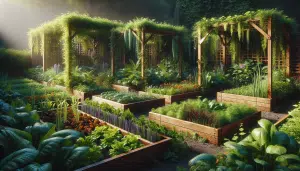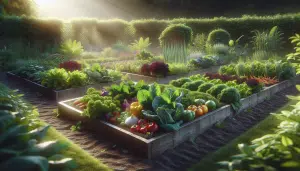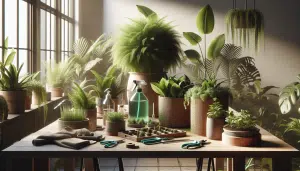What You Should Know About Smart Home Gardening
Lily Carter September 27, 2025
Explore how smart home gardening is changing the way everyday people grow food and flowers indoors and outdoors. This guide offers insights on automated watering, plant sensors, lighting, and sustainable techniques to make gardening simpler, healthier, and more rewarding for any home.
Understanding Smart Home Gardening Basics
Smart home gardening combines technology with traditional gardening techniques to help plants thrive efficiently in any space. By integrating gardening with devices like automated irrigation systems, climate sensors, or app-based monitoring, individuals can create healthier environments for both edible and ornamental plants. Smart gardens are increasingly popular for those seeking convenience, water efficiency, and reliable plant care. These solutions are not just for tech enthusiasts; anyone curious about optimizing routine garden care can explore simple devices that automate watering or measure soil moisture.
One of the most notable benefits of smart gardening is the optimization of resources. With targeted sensors that measure hydration and sunlight, plants receive care tailored to their needs. Smart soil monitors and automated drip irrigation systems ensure that watering schedules are timed perfectly, which can be especially helpful in busy households. These technologies provide both a learning opportunity for beginners and enhanced productivity for seasoned gardeners, who want to scale indoor hydroponic systems or manage large backyard vegetable patches with less manual labor.
Understanding how these systems work can inspire greater creativity in garden design. For homes with limited outdoor space, smart gardening opens doors to vertical hydroponics, wall gardens, or balcony planters equipped with built-in lighting and timers. Even those living in apartments without balconies can experience the satisfaction of fresh herbs or lettuce grown under programmable LED grow lights. Embracing these tools helps make the gardening process hassle-free and environmentally responsible, reducing water waste and maximizing plant health.
Automated Watering and Smart Irrigation Systems
Automated watering systems are central to the smart home gardening experience. These devices, ranging from simple programmable hose timers to advanced drip irrigation networks, are designed to deliver precise moisture when plants need it most. Instead of relying on fixed schedules alone, smart irrigation controllers can adjust water delivery based on weather predictions and sensor feedback. This not only saves homeowners time but also significantly reduces water usage, promoting sustainability indoors and in home landscapes (Source: https://www.epa.gov/watersense/watering-tips).
Some advanced smart irrigation systems integrate seamlessly with smartphones or voice assistants, allowing users to monitor soil moisture, rainfall, and temperature. This adaptability ensures that lawns, gardens, and even potted plants receive accurate care regardless of changing outdoor conditions. Weather-based irrigation is increasingly recommended by city and state utilities seeking to encourage responsible watering practices. For households with vegetable patches or flower beds, this can translate into more robust, disease-resistant plantings and reduced monthly water bills.
Installing smart watering solutions doesn’t have to require professional expertise. Many modern irrigation kits are designed for easy installation, featuring wireless connectivity, plug-and-play moisture probes, and intuitive control panels. This accessibility allows even those new to gardening technology to experiment with automated care routines. Whether curious about maintaining lush perennial borders or ensuring seedling survival, smart irrigation represents a practical solution for varied climates and lifestyles (Source: https://extension.psu.edu/smart-irrigation-technologies).
Plant Sensors and Monitoring Tools at Home
Plant sensors are rapidly gaining popularity among home gardeners due to their ability to provide real-time data. These tools measure soil pH, light intensity, humidity, and temperature at the root zone or foliage level. When hooked to an app or display, they give instant feedback on when a plant needs water or supplemental nutrition. This proactive approach allows for early intervention, preventing common indoor and outdoor plant problems like underwatering or excessive sun exposure. Integrated systems can even trigger alerts or automate watering based on live data.
The availability of smart sensors has broadened the appeal of gardening to people of all skill levels. For families, using sensors offers an interactive, educational approach to understanding plant biology and the environmental factors influencing growth. Some gardeners utilize these devices to fine-tune hydroponic or aquaponic setups, ensuring consistent plant health by adjusting nutrients or water quality as needed. The feedback from smart monitors can help those pursuing sustainable gardening realize more consistent yields and healthier, longer-lived houseplants (Source: https://edis.ifas.ufl.edu/publication/AE555).
Smart plant monitors are also part of a larger movement toward “connected” homes. Integration with other smart devices, like humidity controls or lighting, creates a streamlined ecosystem for optimal plant care. This connectivity is particularly helpful in regions with extreme weather shifts, where maintaining consistent growing conditions is challenging. Ultimately, sensors lower the barrier to success in gardening, offering clear, actionable insights to support a variety of plant species.
Indoor Gardening with Artificial Lighting
Many homes do not have access to the natural light required for healthy plant growth. Here, artificial lighting—especially LED grow lights—steps in as an efficient, low-heat solution for indoor gardens. These lights are engineered to deliver specific wavelengths that plants use for photosynthesis, ensuring compact, robust foliage and vibrant blooms even in windowless rooms. Advanced models can simulate sunrise and sunset, creating a natural rhythm that supports germination and flowering cycles inside any home.
With programmable grow lights and timers, home gardeners can cultivate everything from leafy greens to succulents on kitchen counters, in closets, or as eye-catching wall installations. These lights use less electricity than traditional bulbs and remain cool to the touch, making them suitable for small spaces and around children or pets. As indoor gardening becomes increasingly popular—especially where outdoor space is limited—these LED systems allow for reliable, year-round production (Source: https://extension.umn.edu/houseplants/growing-indoor-plants-artificial-light).
Choosing the right lighting depends on the plant species and the intended outcome—herbs, vegetables, and ornamentals each have varying light needs. Beginners can experiment with adjustable-spectrum bulbs, while enthusiasts may prefer automated fixtures that track plant growth and adjust output. Education resources from university extension offices can help homeowners select and install the most effective lighting solutions for their situation. This technology makes it possible to transform underused corners of the home into lush, productive green spaces.
Sustainable Practices and Resource Efficiency
Smart home gardening supports sustainability by reducing waste, conserving water, and optimizing energy use. Automated watering eliminates overwatering and runoff, while sensors cut down the guesswork in applying fertilizers or pesticides. Some systems collect data for ongoing improvement, so water and nutrients are delivered only as plants require. This approach aligns with broader environmental goals, helping homes contribute to resource conservation even at a small scale (Source: https://www.epa.gov/smartgrowth/smart-growth-and-green-infrastructure).
Many gardeners are drawn to eco-friendly materials in both their technology and hardscaping. Biodegradable seed pods, organic soils, and solar-powered irrigation controllers further cut the carbon footprint of traditional gardening. Vertical gardening systems help urban dwellers achieve productivity in small areas, boosting both food security and biodiversity. Choosing native plants—supported by data from plant sensors—can also limit the need for supplemental watering or fertilizers, improving long-term sustainability indoors and outdoors.
Teaching children or housemates about resource-efficient gardening fosters lifelong habits of stewardship. Schools and community organizations frequently create curriculum around smart garden tech, showing how digital tools can unite food production, environmental responsibility, and cutting-edge innovation. Households experimenting with these strategies often see both cost and yield benefits, as well as a satisfying reduction in wasted effort and materials.
Designing Your Own Smart Garden at Home
Planning a smart home garden begins with assessing goals, available space, and the desired level of automation. For some, this means adding simple self-watering planters or a few soil sensors. Others build fully integrated balcony or backyard systems with app-controlled irrigation, lighting, and climate regulation. The range of possibilities makes smart gardening accessible for all budgets and homes, from apartments to expansive yards.
Start by choosing plants suited to your environment, factoring in light, humidity, and space. Sensors and lighting can be tailored to optimize those conditions. Modular systems scale easily—expanding as interest or time allows—so even small successes can encourage more ambitious projects. Consulting extension office resources or gardening clubs introduces new ideas and connections, while online communities offer troubleshooting and inspiration.
Consistency is the key to enjoying a productive home garden. With sensors, timers, and smart controls handling routine chores, gardeners can spend more time observing, harvesting, and sharing the fruits of their labor. Documenting experiments and results helps not only track progress, but builds a personal reference for what works in your unique setting. Over time, a smart gardening approach can nurture both lush plants and family connections, making home life greener in every season.
References
1. U.S. Environmental Protection Agency. (n.d.). Watering Tips. Retrieved from https://www.epa.gov/watersense/watering-tips
2. Penn State Extension. (n.d.). Smart Irrigation Technologies. Retrieved from https://extension.psu.edu/smart-irrigation-technologies
3. University of Florida IFAS Extension. (2023). Smart Irrigation Sensors and Technologies. Retrieved from https://edis.ifas.ufl.edu/publication/AE555
4. University of Minnesota Extension. (n.d.). Growing Indoor Plants with Artificial Light. Retrieved from https://extension.umn.edu/houseplants/growing-indoor-plants-artificial-light
5. U.S. Environmental Protection Agency. (n.d.). Smart Growth and Green Infrastructure. Retrieved from https://www.epa.gov/smartgrowth/smart-growth-and-green-infrastructure
6. Sustainable Gardening Australia. (n.d.). Smart Gardening. Retrieved from https://www.sgaonline.org.au/smart-gardening/







